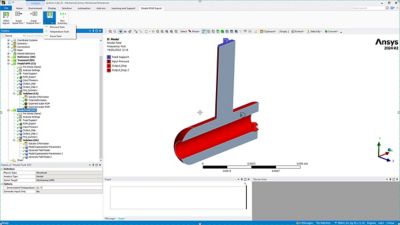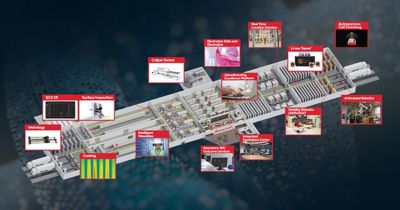-
United States -
United Kingdom -
India -
France -
Deutschland -
Italia -
日本 -
대한민국 -
中国 -
台灣
-
-
產品系列
查看所有產品Ansys致力於為當今的學生打下成功的基礎,通過向學生提供免費的模擬工程軟體。
-

Ansys 推出 Ansys TwinAI 數位孿生解決方案,藉由尖端人工智慧和機器學習 (AI/ML) 技術,將物理模型的準確度無縫整合到取自真實資料的深入分析。TwinAI 軟體提供無與倫比的精準度和速度,同時完全發揮數位孿生的潛力。
此外,在模擬引擎和作業系統資料流方面,Ansys Digital Twin 產品還能讓使用者於更接近雲端基礎架構的環境中建立、驗證及部署數位孿生模型。它能為您帶來三種好處:
- 使用降階模型 (ROM) 或功能型模型單元 (FMU) 建立數位孿生,可利用 Python 程式碼擴充。
- 藉由混合分析提升孿生的準確度,例如使用該領域的新資料來校準現有孿生,或使用 ML 型模型彌補預測和測量之間的差距。
- 簡化並精簡雲端和/或邊緣部署的流程。

降階模型 (ROM) 簡化了複雜模型,可擷取來源模型的行為,讓工程師和設計師能使用最少的運算資源快速研究系統的主要作用。
數位孿生部署的挑戰
部署數位孿生時,通常會遇到一些挑戰。
第一,充分準確地呈現我們想要利用孿生追蹤的資產和效果,是數位孿生建立與驗證的一部份,這通常發生在建模環境中,且該環境不一定與用於部署和執行孿生的環境一致。這些差異可能來自多個層面,例如提供孿生使用之輸入資料的不同機制、用於模擬模型的不同求解器,或是不同作業系統。TwinAI 軟體提供圖形環境以匯入產生的孿生,在需要時交叉編譯模型以於不同的作業系統執行,以及測試和驗證孿生模擬,確保其執行效能和準確度符合部署前的預期。
只需一個步驟就能建立性能強大的精確孿生模型,但要部署數位孿生就需要額外考量。特別是,要如何將孿生執行整合至連接其他應用程式的更大部署工作流程中,例如將所擷取的資料從連線資產傳遞到孿生,以採用時間序列及/或 2D 和 3D 現場資料視覺化形式從孿生收集預測,並使用這些預測取得與孿生消費者相關的關鍵效能指標?在這些方面,TwinAI 軟體能夠以可攜式、可擴充的執行時間應用程式形式來封裝孿生模型,並提供直接的應用程式介面 (API) 來操控和執行孿生。它也能產生支架部署應用程式碼,使用者可以直接使用並延伸這些程式碼,以將孿生整合於部署環境中。
Ansys PyTwin 產品是我們其中一款 Ansys PyAnsys 套件,可讓您存取 Python 版本的 API,並將其整合到任何 Python 式工作流程。除了 Python 與網頁應用程式架構程式碼之外,還有數種選項能提供孿生應用程式的容器化版本,其中包含一組暴露的 REST API,這通常較適合雲端與物聯網應用程式整合。容器的優勢在於它不僅封裝了孿生應用程式,妥善整合及執行所需的所有相依性,因此可以在雲端中輕鬆地進行大規模部署。
如何成功部署您的數位孿生
有幾個範例可用來說明數位孿生部署及其優勢。舉例來說,我們與一家業界領先的流動設備製造商合作,他們希望為一家公用事業公司提供監控解決方案。然而,由於成本和可行性,無法添加診斷感應器。設備製造商運用 Ansys 產品和混合式數位孿生,來建立公用事業公司流量網路的準確物理呈現,且虛擬感應器的預測與實際流速一樣準確。

混合式數位孿生解決方案架構
另一個例子則是鋼鐵或玻璃製造等重度依賴能源的產業,由於高溫和惡劣條件,通常不適合在這類產業安裝實體感測器。能夠從基於物理的模型和簡化順序模型 (ROM) 創建數位孿生,使您能夠快速準確地預測各種數據,有助於控制製造過程並最大化生產品質。(請參閱「模擬讓 Tata Steel 在製造過程中不再受熱能所擾」,「數位孿生如何徹底改變 Tata Steel Nederland 並讓他們達成目標」。)

魚雷罐車從背景可見的高爐運送至鋼鐵廠。影像由 Tata Steel 提供。
「創新能推動進步,而在 Tata Steel Nederland,我們正引領轉型之旅邁向永續發展。運用模擬與 AI 的力量,我們最佳化生產程序、將能源損失降至最低,並朝脫碳目標邁進。Ansys TwinAI 軟體將模擬和資料與 AI 完美結合,從而徹底改變鋼鐵的製造方式,帶來更乾淨、更環保的未來。我們的目標是在 2030 年前達成 30% 至 40% 的 CO2 減排,並在 2045 年前達到碳中和,而 Ansys TwinAI 軟體有助於提升 Tata Steel Nederland 的能源效率並達成我們的脫碳目標。」
— Paul van Beurden,Tata Steel Nederland 研究與開發知識團隊負責人
最後,我們也有機會與全球汽車供應商合作,以展示部署電動車系統的詳細模擬型數位孿生模型之可能性,從而根據使用者選擇的熟悉等級政策來準確預測其範圍。(請參閱「瞭解 EV 距離背後的微積分:多遠才夠遠?」)

所示為搭配 COVESA 車輛訊號規格和 digital.auto 的Ansys 電動車 (EV) 數位孿生整合。代管 COVESA 應用程式介面 (API) 的 digital.auto 平台在前端,而 Ansys EV 數位孿生則在後端運作。
TwinAI 軟體功能是這些不同使用案例的關鍵所在,可協助建數位孿生模型,並以混合分析功能加以延伸,同時透過架構程式碼和容器生成來簡化部署程序。
促進協同作業以利無縫部署
數位孿生的建立與部署活動牽涉多個步驟,通常會由不同人員和團隊處理。其中一部分是建立模型與驗證步驟,這會牽涉到應用程式建模與模擬專家,他們會檢視模型與預測的準確度、穩健性以及執行效能等方面。另一方面,部署活動則會讓較貼近資訊技術和營運的人員參與,他們更關心 API 和應用程式整合與部署。
如前所述,確保應用程式專家建立和驗證的模型能在部署至作業時,以一致的方式重複使用非常重要。TwinAI 軟體能消弭兩邊的鴻溝,協助您集結他們的模型和數位孿生,然後在與他處使用相同技術來部署和執行孿生的環境中,驗證模型和孿生。TwinAI 軟體能產生獨立的可攜式應用程式,且這類應用程式可與提供的 API 整合。
未來發展
我們正在考慮未來發展的多個領域,並將繼續支援您的數位孿生建立與部署。
有項即將實現的重要優點是從建模的角度引進更多的數位孿生創作功能,以簡化建立和執行孿生的完整程序。舉例來說,從即將推出的 2024 R2 版本起,我們將在 TwinAI 軟體中啟動 ROM 功能,讓使用者可以利用單一環境輕鬆建置與部署以 ROM 為基礎的孿生。
另一個重要領域是持續增加混合式數位孿生與 AI/ML 的相關功能,讓我們的物理型孿生能更準確地處理資料,並在現場進行部署時更新。我們也會提供更多部署和 API 相關功能來促進整合和整體部署,從而繼續支援 IoT 合作夥伴和部署生態系統。














